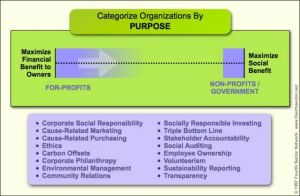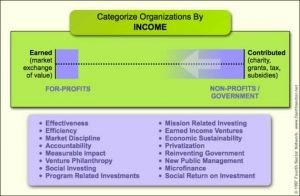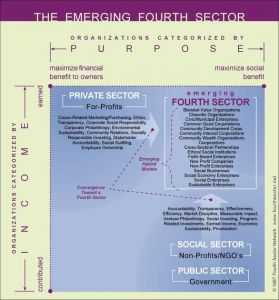第四部门 发表评论(0) 编辑词条
中文解释编辑本段回目录
经济学中, 我们知道有存在传统的三大部门,政府、非盈利组织和企业。
这三个部门各自的
目的: 财务指标最大化--〉社会收益最大化
收入: 社会捐赠--〉自身收益
第四部门是同时具有“社会收益最大化目的”和“收入作为自身收益”的组织总称。
它们包括 :
市民和市属企业;
地区开发金融机构;
跨部门企业联合;
以信仰为基础的企业;
非盈利企业;
可持续发展企业;
社会企业;
等等
The Three Traditional Sectors 编辑本段回目录
Businesses create and distribute goods and services that enhance our quality of life, promote growth, and generate prosperity. They spur innovation, reward entrepreneurial effort, provide a return on investment and constantly improve their performance responding to market feedbacks. They draw on the skills, effort and ingenuity of individual workers, and share with them the economic value created by the enterprise.
Non-profit organizations give us ways to celebrate, build and protect the many human values that give rise to healthy, thriving communities. They have worked to ensure that all people have adequate necessities of life, including clean air, water, food and shelter; an equitable share of wealth and resources; and opportunity to develop their full physical, mental and spiritual potential. They create spaces to celebrate the joy of culture and artistic expression, and reveal opportunities for generosity. They have helped protect the environment, working to ensure that human capacities, technologies and organizations sustain and support, not systemically alter, degrade or destroy, the Earth, its diversity of life or the ecological systems that support life. They remind us that many species share this planet and depend on each other, and that humanity must not only care for itself, but must steward an entire world.
Governmental organizations protect and expand the principles of democratic freedom for both individuals and communities, protecting the public interest while at the same time ensuring a level playing field of opportunity and a common framework of laws and their enforcement at a scale that matches the scale of human activity. They have been granted, or they have presumed, the responsibility to provide for the common security and to make decisions to promote the best interest of society.
The Blurring of Sectoral Boundaries 编辑本段回目录
Over the past few decades, the boundaries between the public (government), private (business), and social (non-profit) sectors have been blurring as many pioneering organizations have been blending social and environmental aims with business approaches.
There are many expressions of this trend, including corporate social responsibility, microfinance, venture philanthropy, sustainable businesses, social enterprise, privatization, community development and others. As this activity matures, it is becoming formalized as a ‘Fourth Sector’ of the economy. To better understand the emergence of the Fourth Sector, it is helpful to study recent shifts in organizational behavior across the three traditional sectors.
Businesses are dedicating more resources to delivering social and environmental benefits. Cause-based marketing, the triple bottom line, and corporate social responsibility are a few of the buzzwords that have come into usage in recent years as part of this trend (for more terms, see Figure 1). Meanwhile, public and social sector organizations are attempting to operate in a more businesslike method (see Figure 2 for examples of trends).
The Convergence of Organizations Toward a Fourth Sector编辑本段回目录
While the mission and method of many organizations in the business, government and nonprofit sectors are becoming steadily more similar, something more than simple blurring of the boundaries is occurring. Pioneering organizations in the three sectors are in fact converging toward a fundamentally new organizational sector that integrates social purposes with business methods: a Fourth Sector (Figure 3).
The Emergence of Hybrid Organizations 编辑本段回目录
In addition to convergence, a second significant pattern of organizational activity has been occurring. The past few decades have seen a proliferation of new hybrid organizational models (Figure 3) formed to address a variety of societal challenges. These organizations consciously blend attributes and strategies from all sectors and thus resist easy classification within the boundaries of the three traditional sectors. But they share two common characteristics-—pursuit of social and environmental aims and the use of business methods—-that position them within the landscape of the emerging Fourth Sector. The following are examples of hybrid organizational models that have emerged in recent years. Many of these terms define overlapping activities, reflecting the state of fragmentation in which the emerging landscape finds itself today.
Chaordic OrganizationsCivic and Municipal Enterprises
Community Development Financial Institutions
Cross-Sectoral Partnerships
Faith-Based Enterprises
Non-Profit Enterprises
Sustainable Enterprises
Community Wealth Organizations
Social Enterprises
Blended Value Organizations
Social Economy Enterprises
附件列表
→如果您认为本词条还有待完善,请 编辑词条
词条内容仅供参考,如果您需要解决具体问题
(尤其在法律、医学等领域),建议您咨询相关领域专业人士。
0

同义词: 暂无同义词
关于本词条的评论 (共0条)发表评论>>
 编辑实验
创建词条
编辑实验
创建词条



